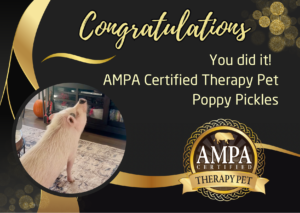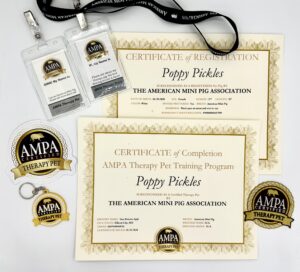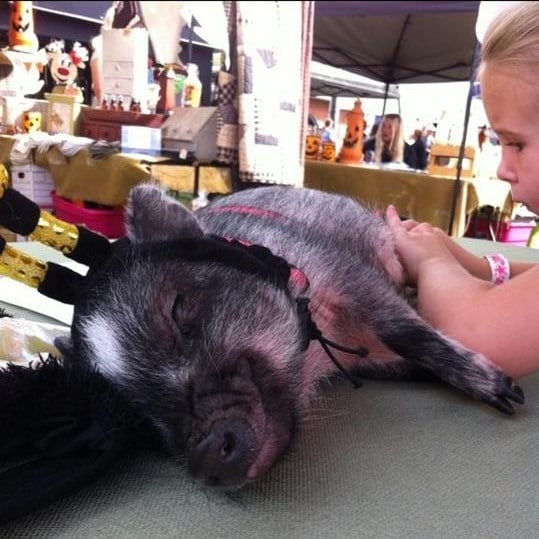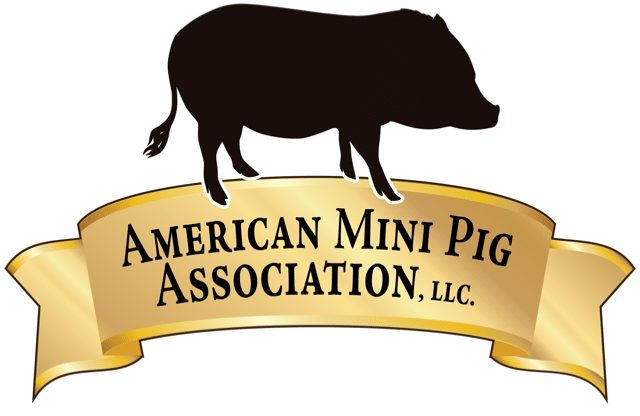Introducing the
AMPA Therapy Pig Training & Certification Program
This self-paced program will lead you on the path to learning what is needed to use your mini pig as a therapy pet in your community. Therapy pets change lives as they visit nursing homes, retirement communities, schools, libraries, and more. Using a mini pig as a therapy animal not only makes a lasting impact on the humans he meets, but it gives the opportunity to educate on the truths of mini pig pet ownership. You and your pig will be ambassadors for the mini pig community while you spread some smiles, laughs, and love to those who may be needing it.
Included in the program is an online educational course that will need to be completed by you, the owner/handler on basic mini pig care and health, educational information about mini pigs to share on your visits, important information on understanding pig behaviors, and essential tools to help you train your pig in preparation for certification.
Your mini pig will begin the training process, if he/she has not already mastered the required skills. You will have all the support you need from the AMPA team to get those skills perfected. We will require video submissions of the required skills once you and your mini pig have mastered them. If your mini pig has already been training and working in the community, you and your pig will be ready to jump right in for certification testing.
Training Your Mini Pig to be a Therapy Pet
Regardless of your goals, it’s important to socialize your pig as early and as often as possible. The more interaction she has with the public, the more she will enjoy therapy visits. Prepare your pig for all the challenges they will face during their visits to keep everyone safe.
There are basic essential skills a mini pig should learn in order to thrive in their therapy visits. Keep in mind, this is a journey not a destination! There are many different environments where people may benefit from therapy visits with your mini pig. Some will require more training and self-control of your mini pig than others. One of the least demanding places is retirement homes whereas one of the most demanding is hospital settings. Find the environment that best suits your mini pig and work together to continue learning and making a difference!
Harness and leash training is at the very core of therapy visits. You may choose to use a wagon or stroller for your visits, but keeping control of your mini pig at all times is important. There will be times the stroller or wagon is not feasible and your pig may need to walk for a short distance, during potty breaks, and getting in or out of the car. For more on harness and leash training see page 38 of the AMPA Mini Pig Training Handbook .
Basic commands are an important part of any training protocol, and have practical applications during therapy visits. At the very least, teach your pig to Sit, Come, Stay, and Leave it on command. These skills will help you to keep control over your pig during visits. It will also help you to reduce his stress or anxiety when something makes him uncomfortable. If a child gets very excited and rushes towards you, the pig may become startled and lose composure. Ask the child to stop and wait for you to approach. Then ask your pig to sit and stay, praise the pig and offer a treat. This helps to distract your pig from the stressor, redirects their focus to you, and offers an emotional reward as positive reinforcement. Now your pig should be completely unphased by the space intrusion and you may approach the child for an interaction on better terms. Come or recall is important to retrieve your pig if he wiggles out of his harness or startles and bolts. Leave it can be used if food or medications are accidently dropped, or your pig becomes focused on something they shouldn’t such as a trash can or a visiting dog. For more information on training these commands, see Chapter 4, page 14 of the AMPA Mini Pig Training Handbook.
Desensitize your pig to hands approaching the face. This is an essential skill for mini pigs in therapy work. You may choose to instruct people to only pet your mini pig behind the head or under the chin, but unfortunately we cannot control the people or their reactions. As good stewards of our mini pigs, we must prepare them for these encounters ahead of time. At home, practice gently stroking your pig’s face while he is eating snacks out of your hands or while he is sleepily enjoying belly rubs. The goal is for face touching to become normalized, and not cause a knee jerk reaction from your pig. Even with lots of handling, your pig may still not be comfortable with hands approaching their face. This is to be expected and is part of their nature. Don’t push too hard, just try to soften your pig’s comfort level and minimize reactions.
For any therapy work, your pig should allow petting by strangers. Start this with your own family at home. Give the pig plenty of affection and positive touch. Ask friends to come over and interact with your pig or visit friends at their houses. Take your pig out for pet friendly errands. Tractor Supply, Home Depot, and Lowes are excellent places when pet pigs are allowed. Pet store can also work, but tend to have a lot more foot traffic, dogs, and unfamiliar animal smells that may overwhelm your pig. You can start with the pig in the shopping cart with a comfortable blanket to snuggle into, or walk on a leash if they are comfortable in the new surroundings. People will flock to visit with the adorable pig! Ask them to reach under the chin for a gentle scratch or pet the pig on the back, respecting the sensitive face area. Keep the interactions one on one so your pig does not become overwhelmed. Watch your pig’s body language. Are they enjoying the interaction and yearning for more? Or are they uncomfortable, hesitating, and trying to retreat? If there is any uncertainty, try a different approach to lessen the stress on your pig. If possible, sprinkle small treats in the blanket in the shopping cart while the stranger reaches to pet, or hold a yummy treat in your hand if the pig is on leash to keep them focused on you during the integration. Take it as slow as your pig needs, these are the building blocks of public interactions! Remember, your pig should enjoy these visits as much as the people.
Teach your pig to take treats gently. Even if you don’t plan to allow visitors to feed your pig, you will want to make sure they are very gentle with approaching fingers. Allowing your pig to be snappy or impatient with treats at home may set them up to snap or nip at little hands that smell like food. For more information on training your pig to take treats gently, see page 21 of the AMPA Mini Pig Training Handbook.
An important skill for therapy work is teaching your pig to focus on you. This has many practical applications and may be used throughout the therapy visit. Public outtings can be very distracting for a pig, sometimes even overwhelming. Asking your pig for their focus gives you control, to ask them to perform other commands or to redirect their focus from something that is dangerous or stressful.
Teaching respect of space will help to set boundaries for your mini pig that will be carried over to their interactions with strangers. Respect should always be first and foremost, no matter who your mini pig is interacting with. If respect is not instilled, the pig will act and react more unpredictably. For more information on teaching respect of space, see page 51 of the AMPA Mini Pig Training Handbook.
While you may not plan on your pig using stairs or ramps, it is essential they can navigate these without causing stress while volunteering. You may be surprised the number of ramps, stairs, and floor changes that must be crossed in public buildings. These skills are relatively easy to teach at home without pressure of unfamiliar environments or bystanders. Take the time before volunteering to get your pig comfortable with different floor surfaces, inclines, and steps. A traumatic stairway experience could really set back your training goals and cause distress to your pig. Change in floor surfaces are often a challenge for mini pigs. Especially going from good traction carpet onto a slippery tile floor. Prepare for success! Learn more about training steps and ramps on page 29 of the AMPA Mini Pig Training Handbook.
Walking through large or unfamiliar doorways may be intimidating for mini pigs. Practice this skill to include the electric sliding doors you find at many pet friendly retail store. Petsmart, Tractor Supply, Home Depot, or Lowes are great places to practice this. Through positive reinforcement and repetition, you can help your mini pig become accustomed to different entryways without hesitation or fear.
Walking through a crowd is a sure-fire way to overwhelm a mini pig that is not used to such foot traffic at their level. Slowly increase their tolerance and acceptance of crowded situations using positive feedback. Lots of praise raise, reassurance, and occasional treats help to reinforce the experience as positive and something to look forward to!
Composure after a loud sudden noise or distraction is an important skill during therapy work. The practical applications are endless. Most pigs are easily startled and go into panic mode. Your pig should be able to recover quickly, with your help if needed.
Riding in a wagon or stroller is an optional but useful skill for therapy pigs. See page 43 of the AMPA Mini Pig Training Handbook.


Learn more about mini pigs at www.americanminipigassociation.com



